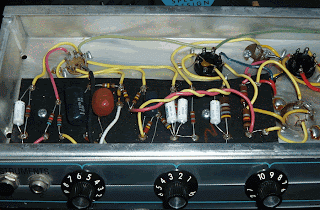
The H&K Red Box is a small DI box that takes your amp's speaker signal as its input, and converts it to a balanced line-level signal to send to your PA or recording mixer. Since the signal is post-power tubes, you get all the tubey goodness in the sound, unlike many Line Out signals. All I own are vintage tube amps with no Line Out at all, so I was very interested in trying the Red Box.
Harp amps often need to be mic'ed, and the Red Box is a good alternative. With the Red Box you never get room effects or bleed-over, and you don't have to futz with the mic placement and angle to get good tone. With the Red Box your "mic'ed" tone is totally repeatable no matter where you play or how little time you have to set up. The Red Box needs no batteries or power adapters; it runs on the phantom power that comes back along the XLR cable from the mixer.
How does it sound? I think it sounds great. It is possible to get a better sound with the right mic and the perfect mic placement, but not often and not easily. The Red Box has a speaker cabinet simulation that gives you a good-to-great sound every time.
First I tried it with a hot-rodded 1970 Fender Champ. Several months ago I replaced the Champ's RCA speaker tap with a Switchcraft 1/4 inch phone plug, so hook-up was easy: The Champ speaker out goes to "Input" on theRed Box. The Red Box has true bypass to send the signal back to the speaker. An XLR cable connects the Red Box to your mixer. I had the cab sim switched on for this recording. The Red Box also has a ground lift switch in case you get some hum. I warmed up the tubes on the Champ so it would get a little hair on the notes, and turned the volume to 6. I hit "record" on the computer and played for a while.
The sound on the recording was impressive. The room I practice/record in is kind of live and boxy, but the recording had none of that (of course). It sounded like a perfectly mic'ed amp, with all the lovely power tube distortion. It did not sound exactly like the Champ, which is a great-sounding 6-watt harp amp, but it sounded very good.
Next I tried it with the Masco ME-18 amp and 2x10 Avatar cab. I wanted to see if the Red Box made it sound the same as the Champ. No way. It reflected all the things I love about the Masco: Huge bottom end, less compression, thumping power. Once again, the Red Box didn't sound EXACTLY like the Masco and Avatar, but it sounded really, really good.
I think the H&K Red Box could be a great tool for harp players. On stage it makes it a breeze to send a good signal to the PA to augment your tube amp. In studios that prefer to use a DI, it sends a better signal that includes your power tubes as an integral piece of your tone package. A pro guitar buddy swears by the Red Box, and he persuaded me to try it.
The street price for the current H&K Red Box is about $120. I found mine on eBay for $55.
 Your harp rig needs some delay. Some guys prefer reverb, but for me a little greasy slap-back is exactly the right sound. Debates rage about which delay pedal is the "best"... Digital or Analog? Digital offers a greater range of delay times and effects, while analog sounds warmer and has a more natural decay to my ear. I've tried 'em all, and I use the Ibanez AD-9 analog delay pedal.
Your harp rig needs some delay. Some guys prefer reverb, but for me a little greasy slap-back is exactly the right sound. Debates rage about which delay pedal is the "best"... Digital or Analog? Digital offers a greater range of delay times and effects, while analog sounds warmer and has a more natural decay to my ear. I've tried 'em all, and I use the Ibanez AD-9 analog delay pedal. You may not know it, but you also need this Boss GE-7 EQ pedal. This thing is the harp player's best friend. Vintage tube amps have little or no tone control, so if you need to tailor the frequency curve of your mic you need an external tool to do it. This is just the ticket
You may not know it, but you also need this Boss GE-7 EQ pedal. This thing is the harp player's best friend. Vintage tube amps have little or no tone control, so if you need to tailor the frequency curve of your mic you need an external tool to do it. This is just the ticket 













